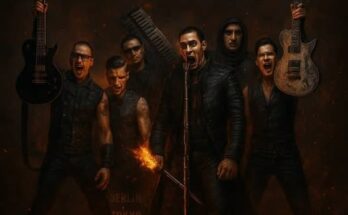All six members of Rammstein are trained pyrotechnicians, a skill essential for their elaborate and often explosive live shows.
Rammstein is not just a band; they are a phenomenon, a living spectacle that fuses industrial metal with theater, shock value, and unparalleled stagecraft. Central to their legend is fire—literal fire that roars, explodes, and dances across their shows with such intensity that audiences often leave describing their concerts as more like a cinematic experience than a typical gig. What sets Rammstein apart is that all six members of the band are trained pyrotechnicians, certified to handle the dangerous flames and explosives that have become synonymous with their name. This unique skill, unusual for musicians, has transformed them into one of the most daring live acts in history and carved out their legacy as masters of controlled chaos.
For most bands, incorporating fire into their performances means hiring outside specialists or pyrotechnic crews to orchestrate carefully timed explosions and flame effects. Rammstein, however, are a different breed entirely. From the early days of their career in the mid-1990s, they decided that to create the level of spectacle they envisioned, they had to take direct control of the flames themselves. This meant studying, training, and becoming licensed pyrotechnicians, ensuring they understood both the artistry and the risks of playing with fire. As a result, every blaze that erupts on stage, every flamethrower worn like a weapon, every explosion detonated with split-second precision, is not just a stunt but an extension of the band’s identity.
This decision to become trained in pyrotechnics was not born of simple spectacle. For Rammstein, fire is more than decoration; it is language. Their music, heavy with industrial riffs and primal energy, demands a visual counterpart that is equally visceral. Fire has always been humanity’s oldest symbol of both creation and destruction, of warmth and devastation. For a band whose themes often revolve around desire, power, rebellion, and the darker shades of human nature, flames are the perfect companion. When Till Lindemann steps onto a stage wearing a coat of flames or when arcs of fire shoot into the air during “Du Hast,” the audience is not merely watching a concert but entering into a ritual of catharsis, a communion of sound and fire.
Becoming trained pyrotechnicians was also an act of necessity. In the early days of their career, the German authorities, as well as concert venues, were skeptical about their use of fire. Stories of mishaps with unregulated flames threatened to undermine the band’s growth. The members knew that to continue pushing boundaries, they would need to ensure absolute safety and mastery over their chosen medium. Thus, they pursued official certifications and rigorous training. Each member, from Lindemann to guitarist Richard Kruspe, learned to handle the materials, understand the chemistry, calculate the risks, and maintain control. This discipline is what separates their spectacle from recklessness. They are not merely entertainers wielding fire; they are craftsmen who understand the science behind the drama.
The scale of their shows has only expanded as their career has evolved. Stadium tours in the 2000s and 2010s saw the introduction of increasingly ambitious pyrotechnics—flame-throwing masks, exploding stages, and towers of fire that lit up entire arenas. Audiences often report feeling the heat of the flames even hundreds of feet away. In one of their most iconic performances, Lindemann strapped a flame-thrower to his back, transforming himself into a human dragon spewing torrents of fire across the stage. These moments are unforgettable not only because they shock and awe but because they are executed with precision and safety that comes only from extensive knowledge. The crowd feels fear, excitement, and wonder all at once, yet subconsciously trusts that the band has everything under control.
The commitment to pyrotechnics also reflects Rammstein’s broader ethos: complete ownership of their art. From their lyrics sung exclusively in German to their refusal to dilute their identity for mainstream English-speaking audiences, they have always chosen authenticity over compromise. By mastering pyrotechnics themselves, they maintain full creative freedom. They do not need to rely on outsiders to interpret their vision or limit their imagination. If they dream of turning a stage into a burning cathedral or a battlefield of explosions, they have the skills to make it happen. This autonomy allows them to seamlessly synchronize fire with music, building performances that feel like operatic spectacles where every flame has meaning.
Of course, the dangers are real. Over the years, there have been accidents and near-misses. Early in their career, band members occasionally suffered burns, and there were moments when the risks felt almost too high. Yet these experiences reinforced their commitment to training, discipline, and constant refinement. Unlike reckless stunts, Rammstein’s pyrotechnics are rooted in professionalism. They have built a reputation not only as provocateurs but also as perfectionists who take safety as seriously as spectacle. This balance of danger and discipline is what makes their shows so compelling. Audiences know that something could go wrong, yet they also sense the mastery that keeps chaos at bay.
It is also worth noting the symbolic weight of Rammstein handling fire themselves rather than outsourcing it. It reflects their philosophy of self-reliance and unity as a band. All six members share the responsibility and the knowledge, just as they share the stage. It is not the work of hired technicians hidden backstage; it is the band itself embracing the flames. This hands-on approach deepens the authenticity of their performance. When fire erupts from a guitarist’s instrument or from Lindemann’s body, it is not a detached trick—it is part of who they are.
The result is that attending a Rammstein concert has become a cultural experience unlike any other. For many fans, it is a pilgrimage, an event that transcends music and enters the realm of theater, ritual, and even mythology. People describe their shows as unforgettable not just for the songs but for the sheer scale of fire, light, and energy. The band’s willingness to risk, to train, and to take responsibility for every flame has elevated them above their peers. They have proven that fire can be more than an effect—it can be an art form.
In the broader history of rock and metal, few acts have dared to integrate pyrotechnics so fully into their identity. Kiss may have breathed fire, and other bands have played with sparks and explosions, but none have made fire their signature language the way Rammstein has. Their decision to become trained pyrotechnicians marked a turning point that ensured their longevity and defined their legacy. It is the difference between gimmick and mastery, between fleeting shock and timeless impact.
Ultimately, the story of Rammstein as trained pyrotechnicians is not just about fire but about passion, control, and dedication to craft. They embody the idea that true art requires total commitment, even if it means studying chemistry, risking burns, or pushing themselves beyond the limits of what most musicians would consider. By owning the flames, they have ensured that every concert is not just a show but an unforgettable inferno, a union of sound and fire that continues to captivate millions. Their legacy burns as brightly as the flames they control, and in the annals of music history, they will forever stand as the band that made fire their eternal stage partner.



